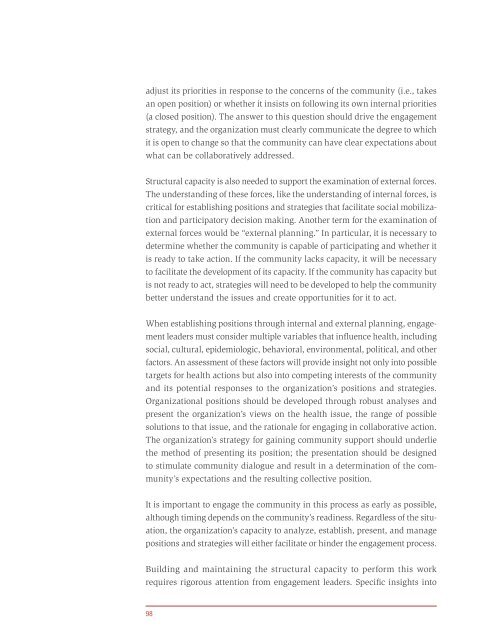Principles of Community Engagement (Second Edition)
Principles of Community Engagement (Second Edition)
Principles of Community Engagement (Second Edition)
Create successful ePaper yourself
Turn your PDF publications into a flip-book with our unique Google optimized e-Paper software.
adjust its priorities in response to the concerns <strong>of</strong> the community (i.e., takes<br />
an open position) or whether it insists on following its own internal priorities<br />
(a closed position). The answer to this question should drive the engagement<br />
strategy, and the organization must clearly communicate the degree to which<br />
it is open to change so that the community can have clear expectations about<br />
what can be collaboratively addressed.<br />
Structural capacity is also needed to support the examination <strong>of</strong> external forces.<br />
The understanding <strong>of</strong> these forces, like the understanding <strong>of</strong> internal forces, is<br />
critical for establishing positions and strategies that facilitate social mobilization<br />
and participatory decision making. Another term for the examination <strong>of</strong><br />
external forces would be “external planning.” In particular, it is necessary to<br />
determine whether the community is capable <strong>of</strong> participating and whether it<br />
is ready to take action. If the community lacks capacity, it will be necessary<br />
to facilitate the development <strong>of</strong> its capacity. If the community has capacity but<br />
is not ready to act, strategies will need to be developed to help the community<br />
better understand the issues and create opportunities for it to act.<br />
When establishing positions through internal and external planning, engagement<br />
leaders must consider multiple variables that influence health, including<br />
social, cultural, epidemiologic, behavioral, environmental, political, and other<br />
factors. An assessment <strong>of</strong> these factors will provide insight not only into possible<br />
targets for health actions but also into competing interests <strong>of</strong> the community<br />
and its potential responses to the organization’s positions and strategies.<br />
Organizational positions should be developed through robust analyses and<br />
present the organization’s views on the health issue, the range <strong>of</strong> possible<br />
solutions to that issue, and the rationale for engaging in collaborative action.<br />
The organization’s strategy for gaining community support should underlie<br />
the method <strong>of</strong> presenting its position; the presentation should be designed<br />
to stimulate community dialogue and result in a determination <strong>of</strong> the community’s<br />
expectations and the resulting collective position.<br />
It is important to engage the community in this process as early as possible,<br />
although timing depends on the community’s readiness. Regardless <strong>of</strong> the situation,<br />
the organization’s capacity to analyze, establish, present, and manage<br />
positions and strategies will either facilitate or hinder the engagement process.<br />
Building and maintaining the structural capacity to perform this work<br />
requires rigorous attention from engagement leaders. Specific insights into<br />
98

















